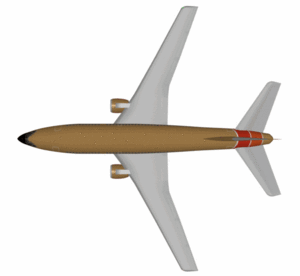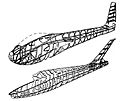Fuselage facts for kids

The fuselage (say: FEW-suh-lahj) is the main body of an airplane. Think of it as the central part that holds everything together. It's where the pilots sit, and where passengers or cargo are carried. Sometimes, even the engines are attached to the fuselage. The word "fuselage" comes from a French word meaning "spindle-shaped," which describes how many airplane bodies look.
Contents
What Does a Fuselage Do?
The main job of a fuselage is to hold the important parts of an aircraft.
- It provides space for the flight crew, like the pilots.
- It carries passengers safely from one place to another.
- It holds cargo, which can be anything from mail to large shipping containers.
- It also connects the wings and the tail of the aircraft. This connection is super important for the plane to fly steadily.
How Fuselages Are Built
Fuselages are built to be very strong but also light. This helps the airplane fly efficiently.
Materials Used
Airplanes need to be tough to handle the forces of flight.
- Most modern fuselages are made from strong, lightweight metals like aluminum.
- Some older or smaller planes might use wood, fabric, or even steel tubes.
- Newer aircraft are starting to use advanced materials called composites, like carbon fiber. These materials are even lighter and stronger than aluminum.
Types of Fuselage Structures
There are different ways engineers design the inside structure of a fuselage.
Truss Structure
- Imagine a bicycle frame made of many tubes welded together. This is similar to a truss structure.
- It uses a strong framework of metal tubes (often steel) to create the shape.
- Then, a lightweight material like fabric or thin metal is stretched over the frame to make the outer skin.
- This design is common in older or smaller aircraft.
Monocoque Structure
- "Monocoque" means "single shell." In this design, the outer skin of the fuselage carries most of the stress.
- Think of an eggshell: it's very strong for its weight because the shell itself supports the load.
- This design is very light, but it can be easily damaged if the skin is punctured.
Semi-Monocoque Structure
- This is the most common type of fuselage structure for modern airplanes.
- It's a mix of the truss and monocoque designs.
- It uses a strong outer skin, but it also has internal frames and stringers (long strips) to give it extra support and shape.
- These internal parts help the fuselage keep its shape and handle the forces of flight, even if the skin gets a small dent.
Different Fuselage Shapes
The shape of a fuselage is very important for how an airplane flies. This is called aerodynamics.
- Most passenger planes have a long, tube-like fuselage. This shape helps them move smoothly through the air.
- Some smaller planes might have a shorter, wider fuselage.
- Cargo planes often have very large, wide fuselages to carry big loads.
- The shape also depends on how many engines the plane has and where they are placed.
Images for kids
-
Sectioned fuselage showing frames, stringers and skin all made of aluminium
-
Interior rear-end of the main passenger level on an Airbus A340, showing the rear bulkhead as well as a doorway opening
-
Rough Boeing 747 interior airframe
-
The fuselage can be short, and seemingly unaerodynamic, as in this Christen Eagle
See also
 In Spanish: Fuselaje para niños
In Spanish: Fuselaje para niños











